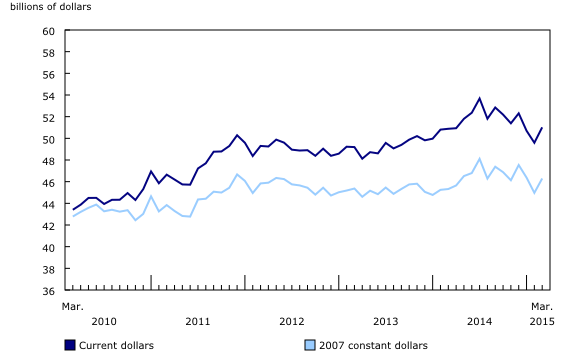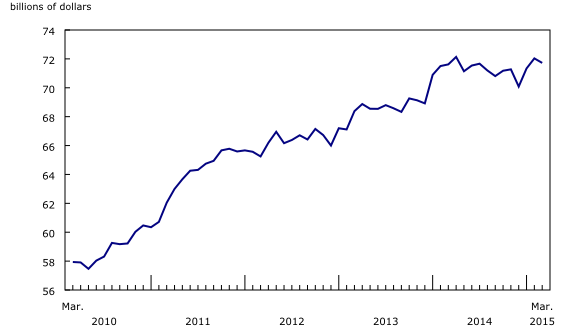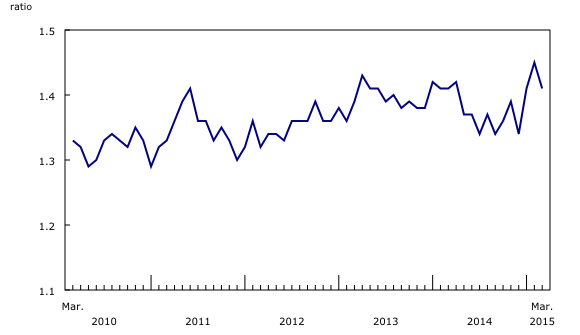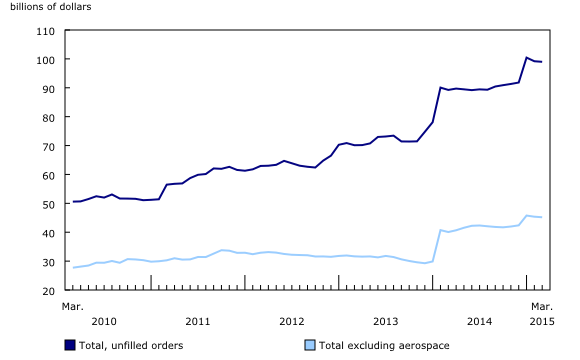Monthly Survey of Manufacturing, March 2015
Archived Content
Information identified as archived is provided for reference, research or recordkeeping purposes. It is not subject to the Government of Canada Web Standards and has not been altered or updated since it was archived. Please "contact us" to request a format other than those available.
Released: 2015-05-15
Manufacturing sales rose 2.9% to $51.0 billion in March, the second increase in six months. An increase in the production of aerospace products and parts coupled with gains in the motor vehicle industry generated higher sales for the month. Partially offsetting the advance was a drop in sales of fabricated metal products. The increase in March followed a 2.2% decrease in February, which was revised to reflect updated information provided by respondents.
Sales rose in 10 of 21 industries, representing approximately 60% of all Canadian manufacturing. Constant dollar sales rose 2.9%, indicating that the volume of goods sold also increased in March.
Aerospace and motor vehicle industries rise
Production in the aerospace industry rose 42.3% in March after falling 29.4% in February. As is typical for this industry, fluctuations in the value of the Canadian dollar had an impact on the production, which is measured in Canadian currency. The depreciation of the Canadian dollar in March caused the value of sales and inventories held in US dollars to increase. Production in the first quarter of 2015 fell 3.9% from the fourth quarter of 2014, marking the second consecutive quarterly decline. However, aerospace production was 6.3% higher in the first quarter of 2015 than in the first quarter of 2014.
Sales in the motor vehicle industry grew 12.8% in March, after declining 18.9% in the previous two months. The declines in the first two months of 2015 reflected shutdowns for retooling at various plants in Ontario. The growth in March reflected higher production as this work started to wind down.
Sales of food rose 3.0% in March to their highest level on record, reflecting widespread gains in the industry.
Partially offsetting those increases was a 3.6% decline in sales of fabricated metal products.
Sales rise in five provinces
Sales rose in five provinces with the largest gains occurring in Quebec and Ontario.
Sales in Quebec rose 6.9% to $12.4 billion in March, their highest value since October 2014. The monthly sales gain in March was the second in six months for the province. The higher sales reflected widespread increases in the aerospace and primary metals industries.
Ontario sales rose 2.6% in March, driven by increased sales of motor vehicles, as factories undergoing retooling began to come back online. In addition, food and motor vehicle parts manufacturers reported higher sales. The gain in total provincial sales followed two monthly declines.
Partially offsetting the gains was a 2.2% decrease in sales in British Columbia, which reflected lower sales of non-durable goods. It was the province's second sales decline in three months.
Inventories decline
Inventories held by manufacturers fell 0.4% in March, the second decline in six months. The lower inventories reflected decreases in the chemical, fabricated metal product and aerospace product and parts industries.
The largest increase in inventories occurred in the petroleum and coal product industry, where inventories rose 1.3% as a result of higher volumes.
The inventory-to-sales ratio fell from 1.45 in February to 1.41 in March. The inventory-to-sales ratio measures the time, in months, that would be required to exhaust inventories if sales were to remain at their current level.
Unfilled orders decline
Unfilled orders were down 0.2% in March, reflecting lower orders in the machinery, computer and electronic product, and fabricated metal product industries. These declines were partially offset by increases in the transportation equipment industry.
New orders rose 5.1%, reflecting higher unfilled orders in the transportation equipment industry.
Note to readers
Monthly data in this release are seasonally adjusted and are expressed in current dollars unless otherwise specified. For more information on seasonal adjustment, see Seasonally adjusted data – Frequently asked questions.
Non-durable goods industries include food, beverage and tobacco products, textile mills, textile product mills, clothing, leather and allied products, paper, printing and related support activities, petroleum and coal products, chemicals, and plastics and rubber products.
Durable goods industries include wood products, non-metallic mineral products, primary metal, fabricated metal products, machinery, computer and electronic products, electrical equipment, appliances and components, transportation equipment, furniture and related products and miscellaneous manufacturing.
Production-based industries
For the aerospace industry and shipbuilding industries, the value of production is used instead of sales of goods manufactured. This value is calculated by adjusting monthly sales of goods manufactured by the monthly change in inventories of goods in process and finished products manufactured. Production is used due to the extended period of time that it normally takes to manufacture products in those industries.
Unfilled orders are a stock of orders that will contribute to future sales assuming that the orders are not cancelled.
New orders are those received whether sold in the current month or not. New orders are measured as the sum of sales for the current month plus the change in unfilled orders from the previous month to the current month.
Manufacturers reporting in US dollars
Some Canadian manufacturers report sales, inventories and unfilled orders in US dollars. These data are then converted to Canadian dollars as part of the data production cycle.
For sales, based on the assumption that they occur throughout the month, the average monthly exchange rate for the reference month (noon spot rate) established by the Bank of Canada is used for the conversion. The monthly average exchange rate is available in CANSIM table 176-0064.
Inventories and unfilled orders are reported at the end of the reference period. For most respondents, the noon spot exchange rate on the last working day of the month is used for the conversion of these variables. Some manufacturers choose to report their data as of a day other than the last day of the month. In those instances, the noon spot exchange rate of the day selected by the respondent is used. The noon spot exchange rate is available in CANSIM table 176-0067. Because of exchange rate fluctuations, the monthly average exchange rate can differ substantially from the exchange rate on the last working day of the month.
Revision policy
Each month, the Monthly Survey of Manufacturing releases preliminary estimates for the reference month and revised estimates for the three previous months. Revisions are made to reflect new information provided by respondents and updates to administrative data. Once a year, a revision project is undertaken to revise multiple years of data. During annual revisions, changes are made to the seasonal adjustment parameters.
Data from the April Monthly Survey of Manufacturing will be released on June 15.
Contact information
For more information contact us (toll-free 1-800-263-1136; 514-283-8300; infostats@statcan.gc.ca).
To enquire about the concepts, methods or data quality of this release, contact Jeff Paul (613-951-7328; jeff.paul@statcan.gc.ca), Manufacturing and Wholesale Trade Division.
- Date modified:





